Watts has announced the next installment in a series of webinars for their engineer, architect, designer, and facility manager customers: Smarter, Safer Hot Water, to be broadcast live on Wednesday, August 28, 2019. This latest webinar will focus on how digital mixing valves enable engineers, designers, and facility managers to directly measure, monitor, and deliver Read more
hot water

Watts has announced the next installment in a series of webinars for their engineer, architect, designer, and facility manager customers: Smarter, Safer Hot Water, to be broadcast live on Wednesday, August 28, 2019.
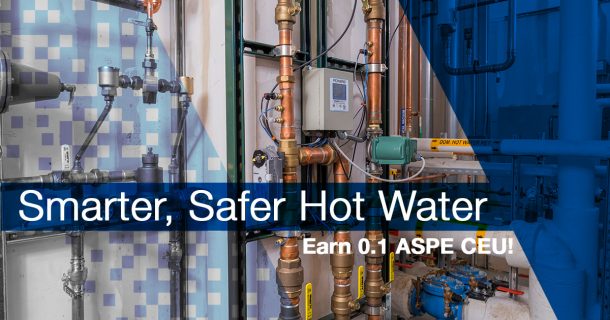 This latest webinar will focus on how digital mixing valves enable engineers, designers, and facility managers to directly measure, monitor, and deliver safer hot water through domestic water systems.
This latest webinar will focus on how digital mixing valves enable engineers, designers, and facility managers to directly measure, monitor, and deliver safer hot water through domestic water systems.
Key points to be covered include an overview of how digital mixing valves:
- Efficiently deliver mixed water throughout a hot water recirculation loop while allowing remote monitoring and control of water temperatures,
- Minimize the risk of waterborne bacteria in high-performance commercial and institutional facilities, and
- Provide precise control needed to deliver high water temperatures that mitigate the risk of the deadly Legionella bacteria (the cause of Legionnaires’ disease) while avoiding the risk of scalding and thermal shock injuries.
By attending the entire webinar, attendees can receive 0.1 Continuing Education Units (CEUs) through the American Society of Plumbing Engineers (ASPE).
To register for this webinar, please visit this page.
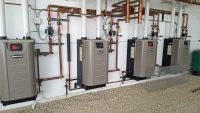
Whether for a single family home, large-scale apartment complex, or commercial or industrial facility, installing a boiler system is a significant investment requiring thoughtful consideration to ensure heating comfort, reliability and efficiency for years to come. Building owners, facility managers, engineers and contractors seek systems that meet specification requirements, installation ease, serviceability, reliability, lower operating Read more
Whether for a single family home, large-scale apartment complex, or commercial or industrial facility, installing a boiler system is a significant investment requiring thoughtful consideration to ensure heating comfort, reliability and efficiency for years to come. Building owners, facility managers, engineers and contractors seek systems that meet specification requirements, installation ease, serviceability, reliability, lower operating costs and higher performance. Once these major parameters are met, buyers also should consider design details that may set one boiler apart from another.
Installation Ease
The installation process can significantly impact the overall cost of any new boiler system. Look for a boiler with design features that aid in simplifying the installation process, thus saving time and money.

An integrated control system that offers a user-friendly setup wizard with intuitive controls will simplify the boiler installation process for contractors.
Boilers with a “door-fit” design are ideal for applications that have limited access. Not having to tear out a wall or door frame can save thousands in installation expense. Likewise, boiler room floor space is always at a premium so zero clearance boiler designs where boilers can be placed side-by-side with minimal clearance is also desired. The key here is that the boiler still remains serviceable.
Sometimes getting a fork lift at the installation site is harder than one would think. Smart packaging and mobile design features that mitigate this need should be a purchase target. Integrated unloading ramps that come as part of the shipping container make the unpacking process quick and easy. Couple this feature with integrated roller casters and the boiler rolls on to the site and is easily positioned into place. If the boiler install includes a concrete pad, the shipping ramp can be used to move the boiler on to the pad as well.
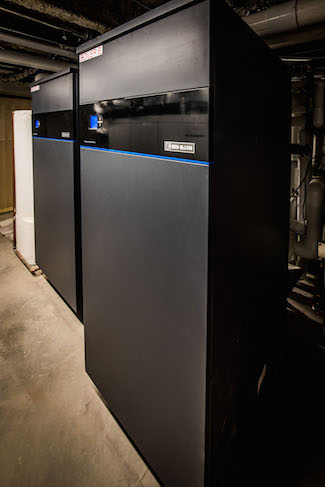
For efficient operation with multiple boilers consider a control system that will fluidly connect different systems to work synchronously to ensure the highest level of performance and efficiency.
Having a correctly-leveled surface is a prerequisite to proper boiler operation and performance. Boiler designs with integrated leveling legs perfectly level the area. Simply position the boiler in place and adjust the leveling legs, which are very similar to the leveling legs on a household appliance but are industrial grade to support the weight of the boiler.
There are a variety of boiler controls on the market that offer varying setup processes and functionality, ranging from simple to complex. An integrated control system that offers a user-friendly setup wizard with intuitive controls will simplify the installation process for contractors. For example, all Weil-McLain condensing boilers, including the new Stainless Steel Vertical Firetube™ (SVF), Evergreen™ and SlimFit™ boilers, include this convenient setup feature in the Unity™Controller (70-3000 MBH).
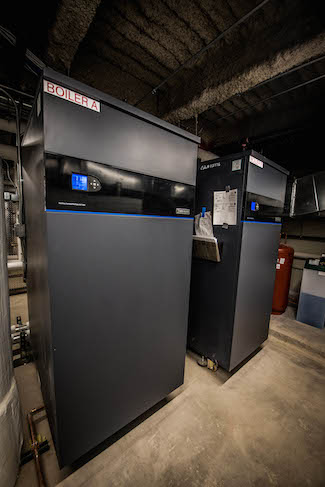
High efficiency is key when selecting boilers. Weil-McLain’s SVF Stainless Steel Vertical Firetube™ (SVF) boiler can be found listed with AHRI with industry leading thermal efficiencies up to 97.1%.
Multiple pre-set systems are another popular boiler control feature. These units feature pre-set heating systems for typical operating conditions built into the controller so installers don’t have to enter specific supply or return temperatures during installation, but rather a specific application which reduces installation costs and time while increasing reliability.
Usability
Simple, user-friendly controls also are essential for efficient boiler operation long after setup is complete. Whether managing a single boiler or a system of boilers, contractors must understand how to leverage system features to optimize performance.
In a multiple boiler system, user controls will manage multiple units to deliver the desired heat and adapt accordingly as the environment changes. For variable primary flow and hybrid boiler system applications, specifically, it is important for user controls to offer configurability between different products and technology. If one boiler in a system goes down, the unified controls will communicate across the units and vary output to adjust for the loss.
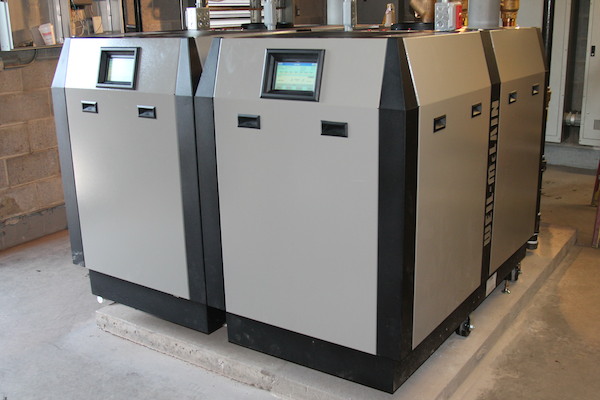
Boiler room floor space is always at a premium so zero clearance boiler designs where boilers can be placed side-by-side with minimal clearance is also desired.
With a straightforward interface and simple navigation, contractors should seek controls that provide at-a-glance boiler status, diagnostics, troubleshooting and integration with building automation systems. The right control system will fluidly connect different boilers to work synchronously and ensure the highest level of performance and efficiency.
Similarly, when expanding a boiler system, controls that maximize energy across all boilers on a system reduces energy costs. Weil-McLain’s SmartSequencing™, for example, controls an algorithm that runs as many boilers as possible at the minimum input, therefore maximizing efficiency. With this advanced control feature, boilers maintain optimal efficiency through lead-lag rotation and balanced heat loading.
Maintenance & Serviceability
Boilers must be well-maintained for their benefits to be fully optimized, and the design of a boiler can have a significant impact on its serviceability over time. Proper inspection and regular native maintenance are vital to ensure uninterrupted, reliable and safe boiler operation. Therefore, contractors will appreciate boilers designed to make annual servicing easier.
Tasks such as cleaning heat exchangers, replacing worn out components, adjusting air fuel mixture, adjusting combustion controls, and maintaining water PH balance will improve boiler efficiency and reduce costly failures, while extending the lifecycle of the unit. Easy access to boiler components will make it easier for contractors to complete these and other critical maintenance activities that support a high-performing unit.

Featuring a proprietary clover-shaped, firetube design, the Weil-McLain SVF heat exchanger provides greater surface area for maximum heat transfer.
Something as simple as selecting a boiler with a hinged cover plate can make the inspection and regular wash down process easier. In these designs, the hinged cover plate can be safely propped open like the hood of a car, granting quick access to the center of the boiler, including the burner and firetubes, for inspection or cleaning. This is especially useful in more compact boiler locations where overhead space is limited.
In addition, consider a design with a serviceable condensate tray that collects condensation during combustion. A boiler designed with a replaceable condensate tray allows for a vulnerable part of the unit to be swapped out quickly and efficiently before an expensive impact to the entire heat exchanger occurs. This improves the longevity of the boiler and reduces maintenance costs considerably.
Efficiency
Commercial-sized boilers are rated according to thermal efficiency, which is the measurement of output heat from the boiler that is transferred into the overall heating system. Higher efficiency boilers offer the most by reducing annual fuel consumption and capturing energy cost savings. Reputable boiler manufacturers are rated and listed by AHRI (Air Conditioning, Heating & Refrigeration Institute), which is a North American trade association of manufacturers of air conditioning, heating, and commercial refrigeration equipment. For example, the SVF Stainless Steel Vertical Firetube™ family can be found listed with AHRI with industry leading thermal efficiencies up to 97.1%.
Opting for a higher-efficiency boiler will result in significant fuel savings for customers, particularly when replacing an older system with a much lower efficiency rating – such as upgrading from 80% thermal efficiency design to 95% or higher. Boilers can account for about 55 percent of annual energy bills, and building owners with high-efficiency boiler systems often report energy cost savings up to 25 percent or more on their heating expenses. In addition, many regions offer efficiency rebates for installing high efficiency boiler systems.
With more boilers on the market offering similar functionality and performance metrics, it can be difficult to differentiate which design is the best for each application. All the particulars that impact a boiler’s installation including usability, serviceability and efficiency can set the superior unit apart from the rest of the field, showcasing a design developed specifically with contractors’ needs in mind. The smallest design details may have the greatest impact on a boiler’s value and performance over time, so choose wisely.
John Miller is the commercial boiler senior product manager with Weil-McLain, a leading North American designer and manufacturer of hydronic comfort heating systems for residential, commercial and institutional buildings.
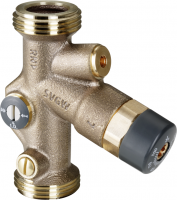
Viega LLC’s new Automatic Recirculation Balancing Valve ensures a balanced domestic water recirculation system by dynamically changing with varying conditions. The Automatic Recirculation Balancing Valve is a modification of a Viega product that has been used successfully in Europe for years. It helps keep water temperatures more uniform by adjusting flow with changes in temperature Read more
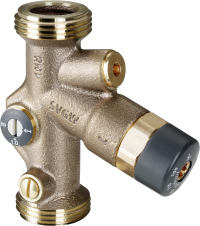 Viega LLC’s new Automatic Recirculation Balancing Valve ensures a balanced domestic water recirculation system by dynamically changing with varying conditions.
Viega LLC’s new Automatic Recirculation Balancing Valve ensures a balanced domestic water recirculation system by dynamically changing with varying conditions.
The Automatic Recirculation Balancing Valve is a modification of a Viega product that has been used successfully in Europe for years. It helps keep water temperatures more uniform by adjusting flow with changes in temperature. The results are faster hot water delivery, minimized waste energy and water and less stagnation and chance of contamination. Among the valve’s features:
- Unlike with manual valves, temperature can be set once and be maintained automatically.
- Settings can be changed easily, if needed.
- Can be installed on risers or branches
- Remote monitoring with temperature sensor
- Optional thermometer provides visual indication of valve setting
- Threaded ends allow it to be used with Viega ProPress or Viega PureFlow fittings systems
- Includes bypass for thermal disinfection
Additional accessories that can be used with the valve include a thermometer, drain valve and optional insulation sleeve.
“Viega is committed to providing hot water quickly and efficiently while improving water quality and the new Automatic Recirculation Balancing Valve is a significant step toward that goal,” said Paige Riddle, product manager, valves. “This valve offers more features than any other on the market while requiring minimum work on the part of designers, engineers, installers and building maintenance personnel.”
To learn more about Viega and its work to improve water quality, click here.
The American Society of Plumbing Engineers (ASPE) is seeking volunteers with a technical background in designing plumbing systems, specifically domestic water heating systems, to participate on Working Group 15 to develop a new American National Standard on system design methods used to regulate the temperature of water exiting a fixture or appliance in domestic water Read more
 The American Society of Plumbing Engineers (ASPE) is seeking volunteers with a technical background in designing plumbing systems, specifically domestic water heating systems, to participate on Working Group 15 to develop a new American National Standard on system design methods used to regulate the temperature of water exiting a fixture or appliance in domestic water distribution systems. Ideal candidates would be plumbing system designers/engineers, piping system experts, code authorities, and others knowledgeable in plumbing system design techniques.
The American Society of Plumbing Engineers (ASPE) is seeking volunteers with a technical background in designing plumbing systems, specifically domestic water heating systems, to participate on Working Group 15 to develop a new American National Standard on system design methods used to regulate the temperature of water exiting a fixture or appliance in domestic water distribution systems. Ideal candidates would be plumbing system designers/engineers, piping system experts, code authorities, and others knowledgeable in plumbing system design techniques.
ASPE 15 is intended to reduce the potential for hot water scalds and related injuries, as well as reduce the risk of thermal shock due to pressure disturbances within the domestic water distribution system. It will fill a void that exists in current product standards by addressing the total system design from the point of entry, through the distribution system, and to the point of use.
The deadline to apply is May 10, 2019. Interested individuals are encouraged to fill out the application here: ASPE Standards Committee Application. For more information, please contact WG 15 Chair, Chris Haldiman, at Chris.Haldiman@wattswater.com or ASPE Sr. Director of Technical & Regulatory Affairs, Ramiro Mata, at rmata@aspe.org.
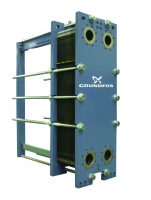
Grundfos provides a full range of gasketed and brazed plate heat exchangers designed for heating, ventilation, air-conditioning and cooling applications. Versatile and reliable gasketed plate heat exchangers feature wavelike corrugation for optimal fluid distribution, leading to the highest heat transfer rates at the lowest pressure drops. A compact and economic option, brazed heat exchangers are Read more
Grundfos provides a full range of gasketed and brazed plate heat exchangers designed for heating, ventilation, air-conditioning and cooling applications. Versatile and reliable gasketed plate heat exchangers feature wavelike corrugation for optimal fluid distribution, leading to the highest heat transfer rates at the lowest pressure drops. A compact and economic option, brazed heat exchangers are made of individually connected corrugated stainless steel plates for simple assembly.

